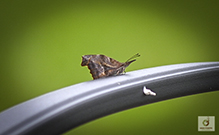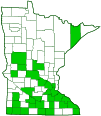American snout
(Libytheana carinenta)
Conservation • Description • Habitat • Ecology • Distribution • Taxonomy
Conservation Status |
|
|||||||
| IUCN Red List | LC - Least Concern |
|||||||
| NatureServe | N5 - Secure SNRB - Unranked Breeding |
|||||||
| Minnesota | not listed |
|||||||
Description |
||
American snout is a small brush-footed butterfly. It occurs in North, Central, and South America. In the United States it occurs from Maine to Florida, west to South Dakota, Colorado, and southern California. Its range extends wherever its hosts, several species of hackberry trees, are found. This includes the southern two-thirds of Minnesota. It is a migratory species. It is a permanent resident in the south and in Mexico. It migrates north every year, sometimes in numbers large enough to darken the midday sky. It appears in Minnesota in May or June, but not in large numbers. It is found in thickets, open deciduous and mixed woodlands, and wooded suburban areas, wherever there are hackberry trees nearby. Adults have a wingspan of 1⅜″ to 2″ (35 to 50 mm). The tip of the forewing is distinctly extended and squared off. The upper side is orange at the base, dark brown near the outer margin, orange near the inner margin, and brown at the tip. There is a row of five squarish spots in the median area near the costal margin, and two widely separated, rectangular, white spots in the postmedial area. The underside is violet-gray at the tip but otherwise reflects the color and marking of the upper side. The upper side of the hindwing is mostly brown above, with a dark brown patch along the outer margin, and a large, orange, post-median spot. The underside is mottled brown and violet gray. The most distinctive feature of this butterfly is the long palps held straight forward appearing snout-like. This is the feature that gives the genus its common name. The snout is thought to have evolved as camouflage. When the butterfly is at rest with wings closed and snout held downward, the wings look like a dead leaf and the snout like the leaf stalk (petiole). |
||
Size |
||
Wingspan: 1⅜″ to 2″ (35 to 50 mm) |
||
Similar Species |
||
| No similar species in Minnesota | ||
Habitat |
||
Deciduous and mixed forests and woodlands, wooded suburban areas |
||
Ecology |
||
Season |
||
Two generations per year: mid-June to early October (Ontario) |
||
Behavior |
||
|
||
Life Cycle |
||
|
||
Larva Food |
||
Young leaves of hackberry trees |
||
Adult Food |
||
Flower nectar from a variety of species, including aster, dogbane, goldenrod, and milkweed. |
||
Distribution |
||||
|
Sources |
|||
| 9/12/2022 | ||||
Occurrence |
||||
Uncommon migratory visitor |
||||
Taxonomy |
|||
Order |
Lepidoptera (Butterflies and Moths) | ||
Superfamily |
Papilionoidea (Butterflies) | ||
Family |
Nymphalidae (Brush-footed Butterflies) | ||
Subfamily |
Libytheinae (beak and snout butterflies) | ||
Genus |
Libytheana (New World snouts) | ||
Subordinate Taxa |
|||
American snout (Libytheana carinenta bachmanii) American snout (Libytheana carinenta carinenta) American snout (Libytheana carinenta larvata) American snout (Libytheana carinenta mexicana) western snout (Libytheana carinenta streckeri) |
|||
Until recently, this butterfly was known as Libytheana bachmanii. In 1992 it was determined that this is the same butterfly that occurs in South America. |
|||
Synonyms |
|||
Libytheana bachmanii Papilio carinenta |
|||
Common Names |
|||
American snout common snout |
|||
Glossary
Costal margin
The leading edge of the forewing of insects.
Palp
Short for pedipalp. A segmented, finger-like process of an arthropod; one is attached to each maxilla and two are attached to the labium. They function as sense organs in spiders and insects, and as weapons in scorpions. Plural: palpi or palps.
Visitor Photos |
|||||
Share your photo of this insect. |
|||||
| This button not working for you? Simply email us at info@MinnesotaSeasons.com. Attach one or more photos and, if you like, a caption. |
|||||
Mike Poeppe |
|||||
 |
|||||
MinnesotaSeasons.com Photos |
|||||
|
|||||

Slideshows |
||

Visitor Videos |
|||
Share your video of this insect. |
|||
| This button not working for you? Simply email us at info@MinnesotaSeasons.com. Attach a video, a YouTube link, or a cloud storage link. |
|||
Other Videos |
|||
| SNOUT BUTTERFLY Libytheana carinenta Rob Curtis |
|||
About
Jan 13, 2019 Libytheana carinenta AMERICAN SNOUT BUTTERFLY, Hennepin-Hopper, Dixon , IL 8/26/2018. Extremely cooperative subject, but the wind kept strongly blowing out of the frame, making shooting very difficult. |
|||
| SNOUT BUTTERFLY Libytheana carinenta harassed Rob Curtis |
|||
About
Sep 29, 2019 Libytheana carinenta SNOUT BUTTERFLY harassed by wasps, slow motion, close up. Montrose Point, Chicago, summer, 2019. |
|||
| Snout Butterfly (Libytheana carinenta) Laying on Hackberry tree (Celtis occidentalis) Mona Miller |
|||
About
May 19, 2017 Tiny white eggs are laid singly on top of the leaves. This is what the egg looked like: https://flic.kr/p/TEAQwu Hobbyists are welcome to learn more about creating habitat and rearing butterflies and moths, please join our conservation group: https://www.facebook.com/groups/butterflyandmothconservation/ |
|||

Created: 9/12/2022
Last Updated:


